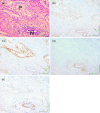Molecular mechanisms of pancreatic carcinogenesis
- PMID: 16367914
- PMCID: PMC11159090
- DOI: 10.1111/j.1349-7006.2005.00134.x
Molecular mechanisms of pancreatic carcinogenesis
Abstract
Pancreatic ductal adenocarcinoma is one of the most fatal malignancies. Intensive investigation of molecular pathogenesis might lead to identifying useful molecules for diagnosis and treatment of the disease. Pancreatic ductal adenocarcinoma harbors complicated aberrations of alleles including losses of 1p, 6q, 9p, 12q, 17p, 18q, and 21q, and gains of 8q and 20q. Pancreatic cancer is usually initiated by mutation of KRAS and aberrant expression of SHH. Overexpression of AURKA mapping on 20q13.2 may significantly enhance overt tumorigenesity. Aberrations of tumor suppressor genes synergistically accelerate progression of the carcinogenic pathway through pancreatic intraepithelial neoplasia (PanIN) to invasive ductal adenocarcinoma. Abrogation of CDKN2A occurs in low-grade/early PanIN, whereas aberrations of TP53 and SMAD4 occur in high-grade/late PanIN. SMAD4 may play suppressive roles in tumorigenesis by inhibition of angiogenesis. Loss of 18q precedes SMAD4 inactivation, and restoration of chromosome 18 in pancreatic cancer cells results in tumor suppressive phenotypes regardless of SMAD4 status, indicating the possible existence of a tumor suppressor gene(s) other than SMAD4 on 18q. DUSP6 at 12q21-q22 is frequently abrogated by loss of expression in invasive ductal adenocarcinomas despite fairly preserved expression in PanIN, which suggests that DUSP6 works as a tumor suppressor in pancreatic carcinogenesis. Restoration of chromosome 12 also suppresses growths of pancreatic cancer cells despite the recovery of expression of DUSP6; the existence of yet another tumor suppressor gene on 12q is strongly suggested. Understanding the molecular mechanisms of pancreatic carcinogenesis will likely provide novel clues for preventing, detecting, and ultimately curing this life-threatening disease.
(Cancer Sci 2005).
Figures



References
-
- Matsuno S, Egawa S, Fukuyama S et al. Pancreatic Cancer Registry in Japan: 20 years of experience. Pancreas 2004; 28: 219–30. - PubMed
-
- Nomura K, Sobue T, Honma I et al. eds. Cancer statistics in Japan 2003. Tokyo: Foundation for Promotion of Cancer Research (FPCR); 2003.
-
- Fukushige S, Waldman FM, Kimura M et al. Frequent gain of copy number on the long arm of chromosome 20 in human pancreatic adenocarcinoma. Genes Chromosomes Cancer 1997; 19: 161–9. - PubMed
-
- Abe T, Makino N, Furukawa T et al. Identification of three commonly deleted regions on chromosome arm 6q in human pancreatic cancer. Genes Chromosomes Cancer 1999; 25: 60–4. - PubMed
-
- Kimura M, Abe T, Sunamura M, Matsuno S, Horii A. Detailed deletion mapping on chromosome arm 12q in human pancreatic adenocarcinoma: identification of a 1‐cM region of common allelic loss. Genes Chromosomes Cancer 1996; 17: 88–93. - PubMed
Publication types
MeSH terms
LinkOut - more resources
Full Text Sources
Other Literature Sources
Medical
Research Materials
Miscellaneous

